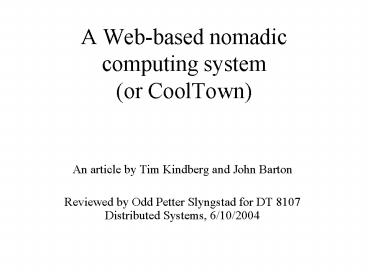A Webbased nomadic computing system or CoolTown - PowerPoint PPT Presentation
1 / 13
Title:
A Webbased nomadic computing system or CoolTown
Description:
A Web-based nomadic computing system (or CoolTown) An article by Tim Kindberg and John Barton ... the developed process is an alternative, based on context ... – PowerPoint PPT presentation
Number of Views:78
Avg rating:3.0/5.0
Title: A Webbased nomadic computing system or CoolTown
1
A Web-based nomadic computing system (or
CoolTown)
- An article by Tim Kindberg and John Barton
- Reviewed by Odd Petter Slyngstad for DT 8107
Distributed Systems, 6/10/2004
2
Introduction
- Web properties relevant to nomadic computing
- Ubiquitous access pervasive computing
- Just enough middleware supports adaptation
- Locality global access not always necessary
3
Nomadic Computing Issues
- Interaction with (local) environment as opposed
to exchange of documents - Inadequate model for resource discovery
- URLs cannot be used as routine identifiers too
volatile - Web is largely read-only
- but in CoolTown, things are different
4
CoolTown (the nomadic computing model)
- Assumptions
- Nomadicity users are mobile
- Handy devices systems support PDA-like devices
- Wireless communications simple, fast I/O
expected - Heterogeneity these devices are diverse both by
function and communication - Fixed resources printers, kiosks, teller
machines - Wired backbone to support the fixed resources
5
Sensing
- Automatic discovery, options
- IR RF
- Barcodes
- Electronic tags
- Optical recognition
- Direct (URL) vs. indirect (via resolver) sensing
6
Example of PDA setup
7
Context physical discovery
- User designates what is of interest in the
context (both physical and virtual) - Issues
- Discovery finding contexts resources
- Hierarchy and context overlap links
- Simple bootstrapping automatic root context
- Scope user defined
8
Context physical discovery (2)
- Implementation
- Place managers
- Provides access to configuration of resources
- Acts as resolver, Web server (html, xml)
- Physical registration
- Designating what is relevant in the context, as
well as where that context is relevant
9
Exhibition hall example
10
Exhibition hall example (2)
- Instantiation create new place context at the
Place manager - Physical linkage configure beacons/barcodes
- Collection sense identifiers for context
- Resolver configuration obtain web presences
- Registration insertion of URLs
- Presence-tying linking
11
Exchange of Content
- Direct post (A)
- Simple push interaction
- Indirect post (B)
- links to other content
- Devices as clipboards temporary storage
- Setting options on the sink (C)
12
Discussion
- Places (and their context) may include additional
constraints (time of day), be active - Context not necessarily tied to a place (could
be almost anything) - Investigating shared contexts (individuals,
groups) - Discovery registration mechanisms cell-based,
triangulation, network discovery the developed
process is an alternative, based on context - Privacy unfamiliarity vs. transparency
- Spontaneous networking need content-oriented
computing to succeed (web vs. Jini or CORBA
presence)
13
Conclusion
- - The ability to connect physical objects with
their web presence is critical to CoolTown - - The authors acknowledge that much work remains
before nomadic computing can be realized on a
large scale































